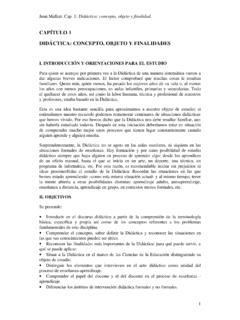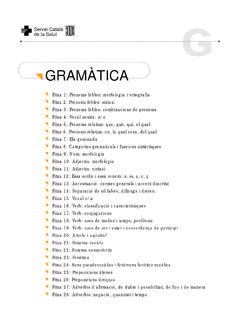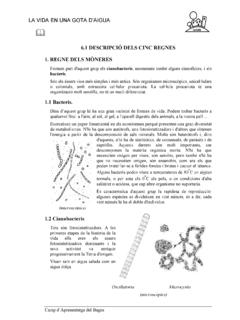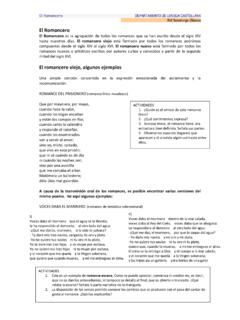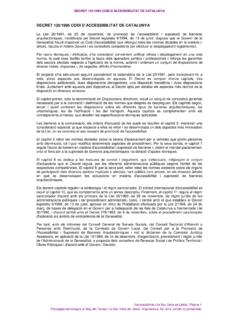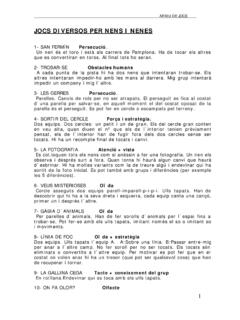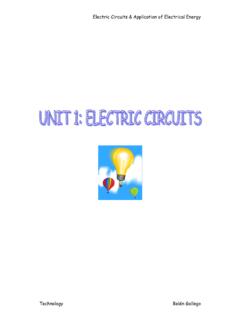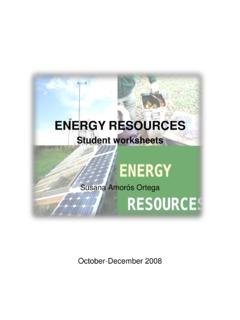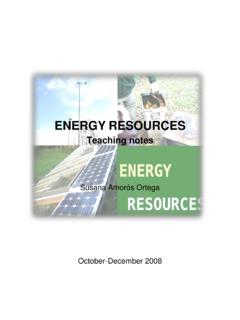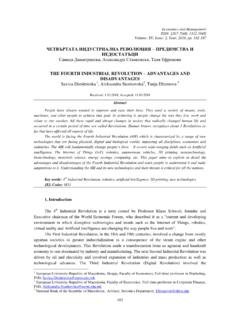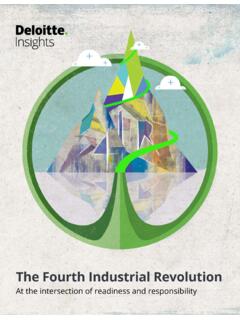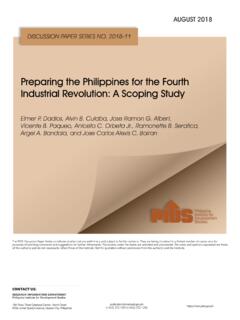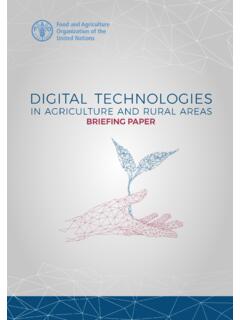Transcription of THE INDUSTRIAL REVOLUTION Student's worksheets
1 THE INDUSTRIAL REVOLUTIONTHE INDUSTRIAL REVOLUTIONS tudent's worksheetsLaura Calzado VillavecchiaOctober- December 2009 Laura Calzado Villavecchia CEIP Dolors Monserd -SantapauTHE INDUSTRIAL REVOLUTIONWs1 INVENTIONS IN THE 19th centuryPut these inventions in chronological order and compare your ideas with yourpartner. Then, write them on the Time line provided adding James Watt's steammachine invented in 1769. In 1885 Benz invented the car Edison invented the electric bulb in 1882 Fulton invented the first steamboat in 1803 Stephenson invented the steam locomotive in 1825 In 1877 Edison invented the phonograph In 1876 Graham bell invented the telephone The Lumiere brothers invented the cinematograph in 1895 Densmore invented the typing machine in 1872 To report, use this.
2 The first invention was the steamboat, invented by Fulton in 1803 The firstThe secondThe thirdThe fourthThe fifthThe sixthThe seventhThe Calzado Villavecchia CEIP Dolors Monserd -SantapauTHE INDUSTRIAL REVOLUTION Ws2 Laura Calzado Villavecchia CEIP Dolors Monserd -Santapau 18001750 l_____l_____l 1900 TIME LINE : INVENTIONSTHE INDUSTRIAL REVOLUTION LIFE IN THE COUNTRYSIDE in the 19th century Ws3 Imagine you are a child from the countryside in the 19th century. What are you doing?
3 Where are you at the moment? What are you wearing? Is somebody with you? ..Draw a picture of yourself. MyselfWord Bankeating working picking up stonesscaring birds movingstudyingin the fieldat homeoutsidevestshirttrousersMeAnswer:Wha t are you doing?I'm_____Where are you at the moment?_____What are you wearing?_____My friendAsk:What are you doing?_____Where are you at the moment?_____What are you wearing?_____Laura Calzado Villavecchia CEIP Dolors Monserd -SantapauTHE INDUSTRIAL REVOLUTION CHILDREN AT WORK in the 19th century Ws4 Search in , complete thequestions below and choose one photo about a working Children in coal mines Why was coal so important?
4 A)What did steam engines burn?B)What did steam engines drive?C)The coal had to be dug from _____D)Did Britain have a lot of coal?What jobs did children do in mines?E)What jobs did children do in mines?2. Children at workWhat jobs did children do?F)Where did children work?3. Rich and poor familiesSlum childrenG)Where did poor children live?H)What is a slum?Choose one photo of a working child and report to the class:This child is a ..We chose this photo because there is ..there are ..you can see ..Laura Calzado Villavecchia CEIP Dolors Monserd -SantapauTHE INDUSTRIAL REVOLUTION Ws5 CHILDREN AT WORK in the 19th centuryYou are going to watch a video clip about a child at work.
5 Look at the questions belowand, with a partner, decide what you need to find # does he live? old is this child? you think he's happy or unhappy? it a hot or a cold day? much money does he receive? he with other children or is he alone?Laura Calzado Villavecchia CEIP Dolors Monserd -SantapauTHE INDUSTRIAL REVOLUTIONTHE CATALAN INDUSTRY in the 19th century Ws6 Laura Calzado Villavecchia CEIP Dolors Monserd -SantapauA Bonaplata brothers in 1832-We have capital -We have an idea: to build the first textile factory with steam machines. We like the idea of using steam power.
6 Our factory is called El Vapor . The factory is a big building with lots of machines working at the same We have a problem: we need coal to need coal, it comes from England or Asturias to Barcelona. -We live in Barcelona, so the factory is in the city. B Vidal family, around 1892 -We have capital-We have an idea: to build a textile factory-We have a problem: coal is very expensive. Solutions: - We think on the water power from rivers to move , we build a textile community in Puig Reig, on Llobregat riverside. Some years later, we buy a steam machine because the water level is irregular. We buy coal from F gols the Textile community there are lots of workers.
7 We build flats for them, next to the factory. We build shops, a church, a school and a playground for children to play too. THE INDUSTRIAL REVOLUTIONTHE CATALAN INDUSTRY in the 19th century Ws7 Laura Calzado Villavecchia CEIP Dolors Monserd -SantapauC Textile factory owners in Matar in 1848-We have money and many factories in Matar using steam have an idea: to send our products overseas from Barcelona have a problem: the transport by cart is too slow, it takes a lot of pay to build a railway from Matar to Barcelona. It will be the first in Spain. THE INDUSTRIAL REVOLUTIONTHE CATALAN INDUSTRY in the 19th century Ws8D Interview Bonaplata brothers, Vidal family and some owners in Matar.
8 Make notesabout what they say. Think of one more question to ask them. Bonaplata brothersVidal familyOwners in Matar 's your idea? do youhave? powerdo you use tomove machines?4. What do youbuild? do youbuild? your group, after the interview, write one sentence to describe a factory and factory:_____A capitalist:_____Laura Calzado Villavecchia CEIP Dolors Monserd -SantapauTHE INDUSTRIAL REVOLUTIONL aura Calzado Villavecchia CEIP Dolors Monserd -SantapauBRITISH INDUSTRY IN XIX CENTURYWs9 CATALAN INDUSTRY IN XIX CENTURY THE INDUSTRIAL REVOLUTIONWs10 BRITISH AND CATALAN INDUSTRY IN XIX CENTURY (I) Look at the two maps and answer the questions.
9 Do it with your does the map key show? the grid with the name of the BritainIn CatalunyaCotton textileWoollen Catalan and British cities are a river:Near the you think these cities have a high or low population? Why? kind of work do you think most of the people do in these cities? look at the map of Europe on the next page. Colour Britain (England andScotland) and British ports do you think the coal came from to Asturias and toBarcelona? Mark on the map the shortest way for the coal to come to Calzado Villavecchia CEIP Dolors Monserd -SantapauTHE INDUSTRIAL REVOLUTIONWs11 BRITISH AND CATALAN INDUSTRY IN XIX CENTURY (II)MAP OF EUROPEFrom Calzado Villavecchia CEIP Dolors Monserd -SantapauTHE INDUSTRIAL REVOLUTION Ws12 YOUNG MINERS in the 19th century At the age of ten I became a drawer.
10 I dragged coal through the mine. I wore achain and girdle, I did not like it, it hurt me; it rubbed my skin off; I often felt got 15d (about 6p) each day. I had no time to eat a bit of meat from morning tonight. I crawled on hands and feet. There was not room to stand . A drawer, 1840 I'm a trapper in the Gauber pit. I open and close a door called a trap . I have to doit without a light and I'm scared. I go at four and sometimes half past three in themorning, and come out at five or later (at night). I never go to sleep. Sometimes Ising when I've a light but not in the dark; I dare not sing then. I don't like being inthe pit. (Sarah Gooder, a trapper aged eight)(Texts from Frampton, M (1997)Victorian Britain, Folens)Laura Calzado Villavecchia CEIP Dolors Monserd -SantapauTHE INDUSTRIAL REVOLUTION Ws13aYOUNG MINERSin the 19th centuryWork with your partner to write a dialogue between the trapper and the drawer.
